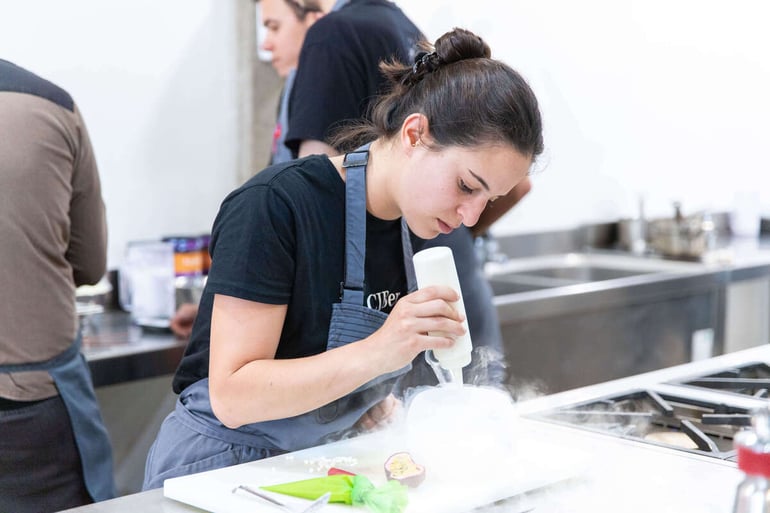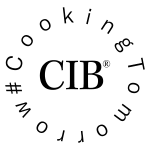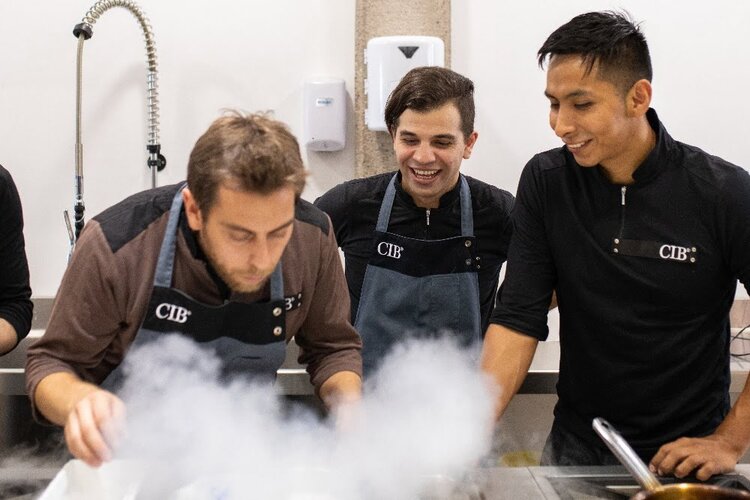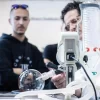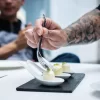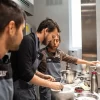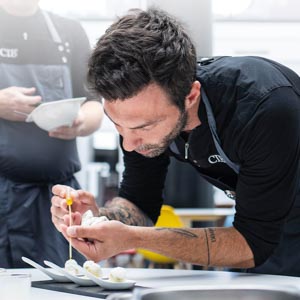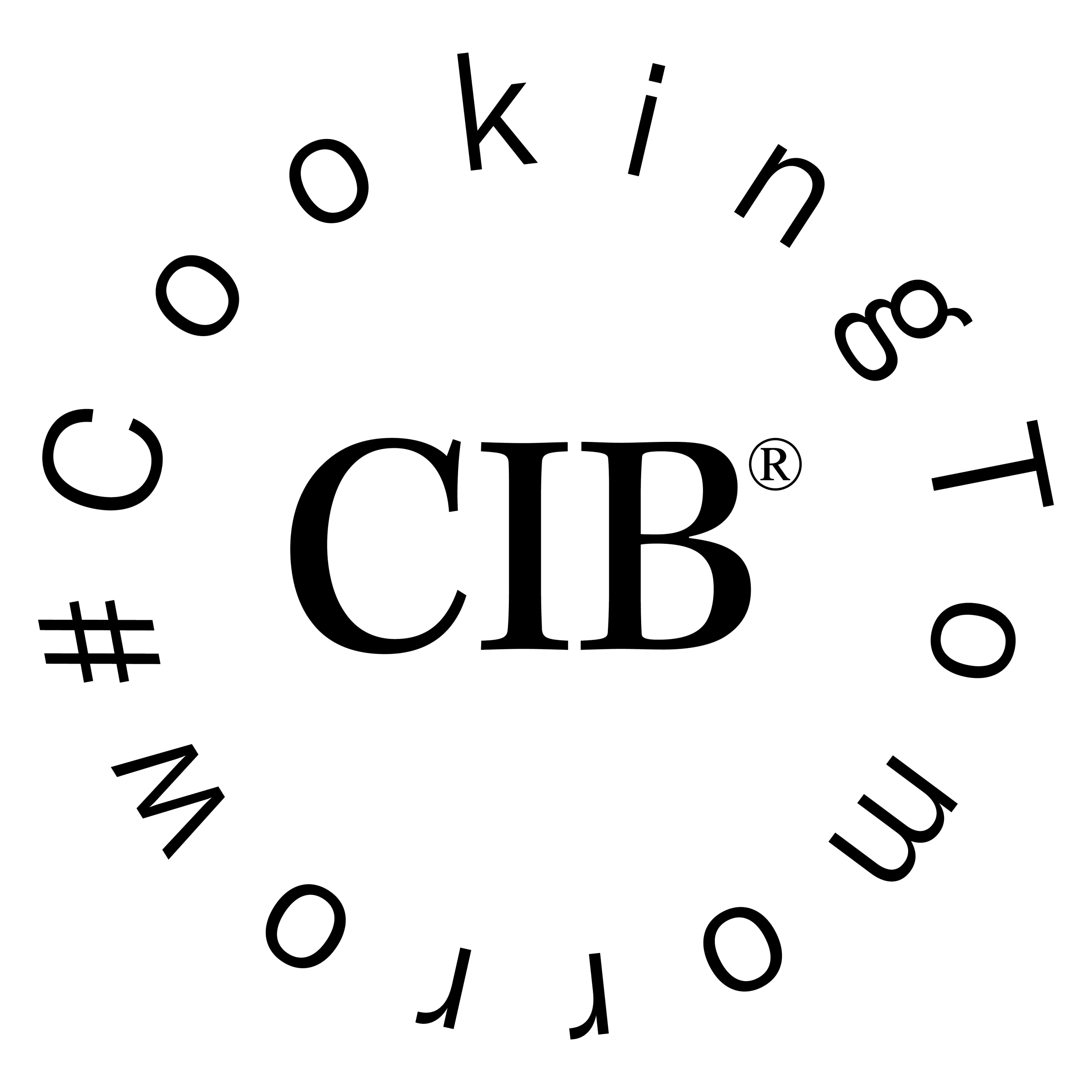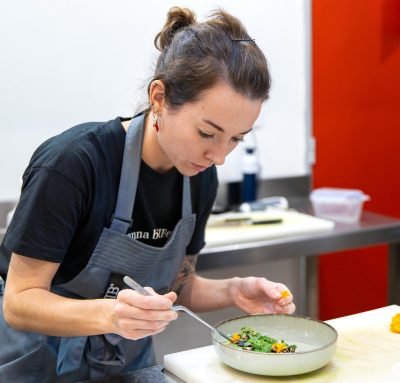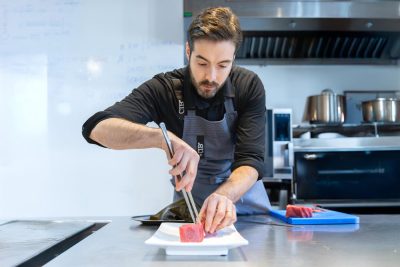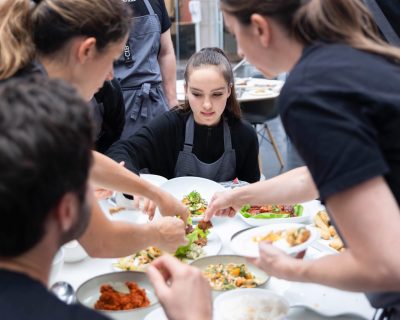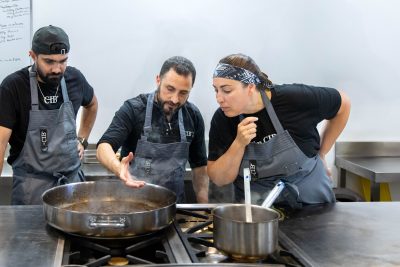Molecular gastronomy involves combining multiple ingredients, chemical and physical processes to achieve a novel and delicious end result, without forgetting scientific rigor. In this post, we are going to see some of the most popular molecular cuisine techniques that students study on the Postgraduate course in Advanced Culinary Techniques at the CIB.
Spherification. Using liquid nitrogen in molecular gastronomy
It involves using one of the principles of gelification and a gelling agent called sodium alginate that comes from algae, which is joined to a calcium salt to encapsulate a liquid or semi-solid food. The result is liquid spheres inside that explodes when eaten, sometimes imitating the appearance of fish eggs, called “false caviar”.
The spherification technique comes from the food industry, but was first seen at the restaurant El Bulli, and thanks to science (or molecular gastronomy), it has been perfected. It’s a sphere that, when eaten, produces a burst of sensations in the mouth as the thin layer of gel that envelops a liquid is broken.
Nowadays, the technique has evolved to the point of obtaining spheres joined together to obtain surprising and amusing textures, called multiple spherification.
Vacuum impregnation in molecular gastronomy
Vacuum impregnation is a technique used by creative cuisine chefs, with the aim of giving a food a flavor and a color that it does not naturally have. To do this, a solid food, but with certain porosity, submerged in a liquid, must be subjected to a high vacuum, and if necessary, the vacuum can be applied more than once to impregnate it better.
When atmospheric pressure is restored, the external liquid flows into the pores, thus allowing an impregnation of color or flavor, or both, to the food and achieving a new product.
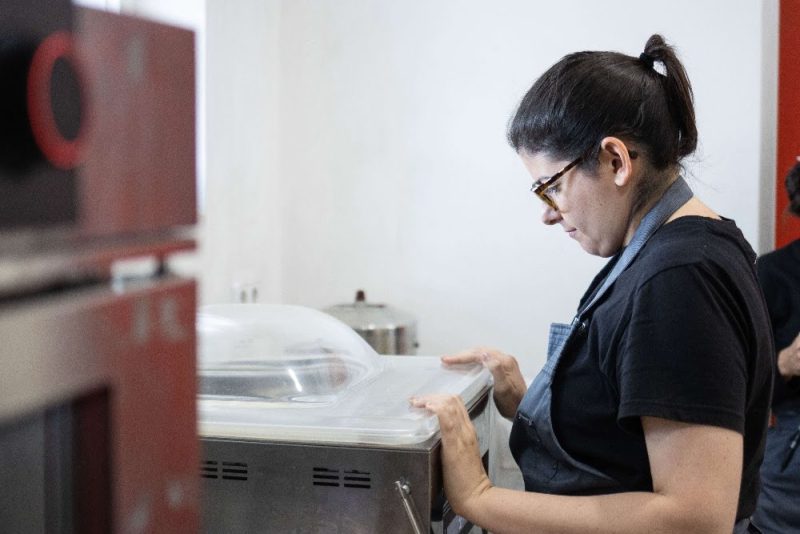
Freeze-drying
Freeze-drying is a food preservation method that combines different processes, such as freezing, vacuum and sublimation. The result is a dry product that maintains most of the organoleptic characteristics of its original state, such as aroma, taste or flavor.
Freeze-drying is carried out in special equipment called a freeze-dryer, in which the processed product is introduced ready to eliminate its water and dried. The food is frozen at very low temperatures, less than -40ºC. Once frozen, a vacuum is applied and the temperature is gradually raised, causing the sublimation process.
This process, sublimation, means taking the water out of the food. The water in solid state (frozen) is transformed into gas without passing through the liquid state and as such the nutritional and organoleptic qualities of the food are maintained. The lower the freezing temperature of the food, the smaller the frozen water crystal will be and the less chance there is that structures such as fibers, proteins and other nutrients of the food will break, therefore, keeping the quality of the gastronomic product as high as possible.
Some foods that undergo freeze-drying in the food industry are:- Instant coffees- Aromatic herbs for cooking- Instant preparations such as risottos and powdered soups.- Fruits in breakfast cereals (banana, berries…)- Powdered fruit juices- Cow’s milk extracts used in baby milks
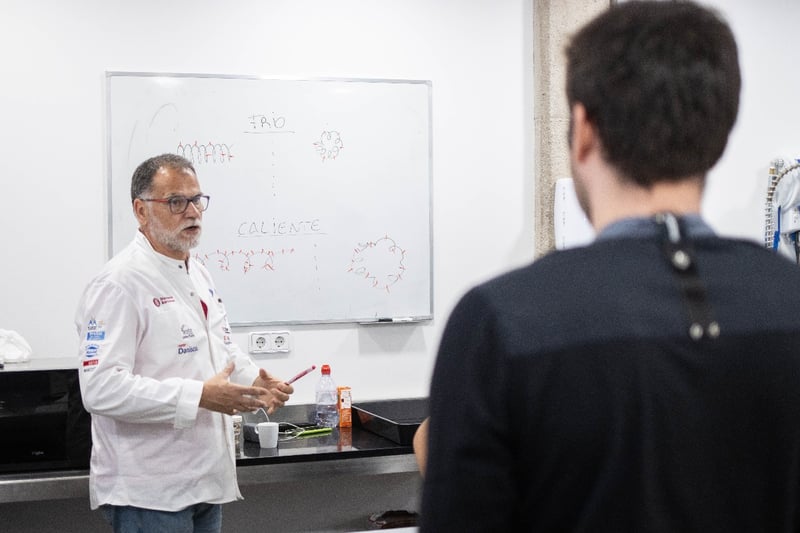
Use of liquid nitrogen in molecular gastronomy
Nitrogen is an inert gas that makes up about 78% of the air in the atmosphere. It is one of the products used in the food industry to achieve freezing at very low temperatures, to deep-freeze your products. As liquid nitrogen is at -196ºC, it allows for very fast freezing, causing very small water crystals in the food, and therefore, this food preserves its organoleptic characteristics in the defrosting process. It is one of the Postgraduate course in Advanced Culinary Techniques student’s favorite techniques.
In 1894, cooking and ice cream expert Agnes Marshall cited in her book Fancy ices the culinary use of liquid nitrogen. A century later, in the mid-1990s, Michel Bras and Hervé showed the advantages of preparing ice cream with nitrogen, but it remained a culinary experimentation (molecular gastronomy) that did not transfer to the kitchen. Heston Blumenthal, from Fat Duck, was the one who recovered the use of liquid nitrogen together with physicist Peter Braham. In 2000, he obtained his first frozen foam.
At the same time, Ferran Adrià (El Bulli) and Dani García (Tragabuches) also incorporated liquid nitrogen as a new technique to freeze products and preparations in their kitchens to make new creations.
Today, cooking techniques that go beyond the first sorbets created with liquid nitrogen can be used. Some of these can be combined to obtain foods such as powders and numerous types of ice creams; you can also play with the texture in frozen soups or gazpachos, and create a fog effect for service, since liquid nitrogen evaporates when it is brought to room temperature.
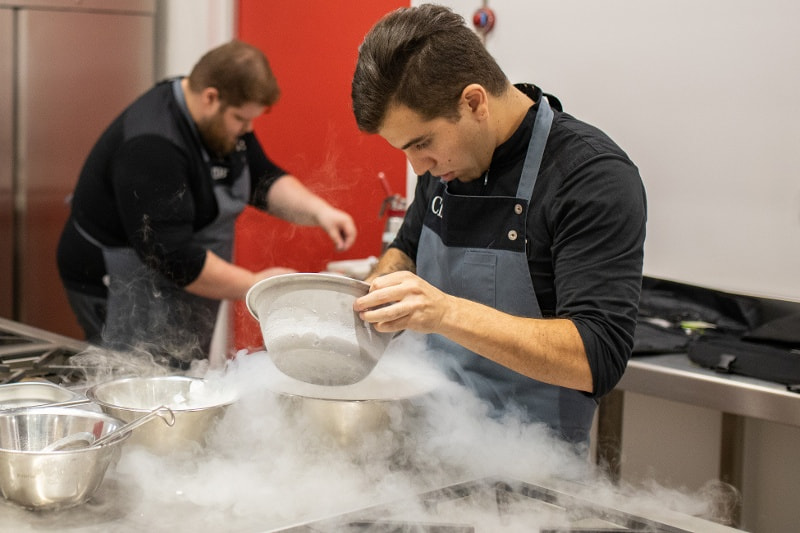
Gelling technique in the kitchen
A gelling agent is a substance that has the ability to form gels. Due to their properties, the gelling agents currently used in gastronomy belong to the family of hydrocolloids. These products can be either carbohydrates such as fibers, such as the well-known pectins, or proteins such as fishtail gelatine.
The gelling technique involves turning liquid into a gel or semi-solid, but this gelling agent must first be properly hydrated in the food to be gelled, otherwise the technique will not work. In the liquids that are to be gelled, there must be a minimum percentage of water and heat must be applied to the mixture of the gelling agent and the food in order to achieve the desired texture. Some of the best known products to give this gel-like texture to food in the world of gastronomy are plant-based and include agar-agar, carrageenans, sodium alginate and pectins. Fish tail gelatine is also an option from the world of non-plant-based products.
The important thing to remember when working with them is to understand their behavior and their limitations, so that you can then make your own creations in the kitchen and not replicate those of other chefs, as you do not have all the knowledge about the product.
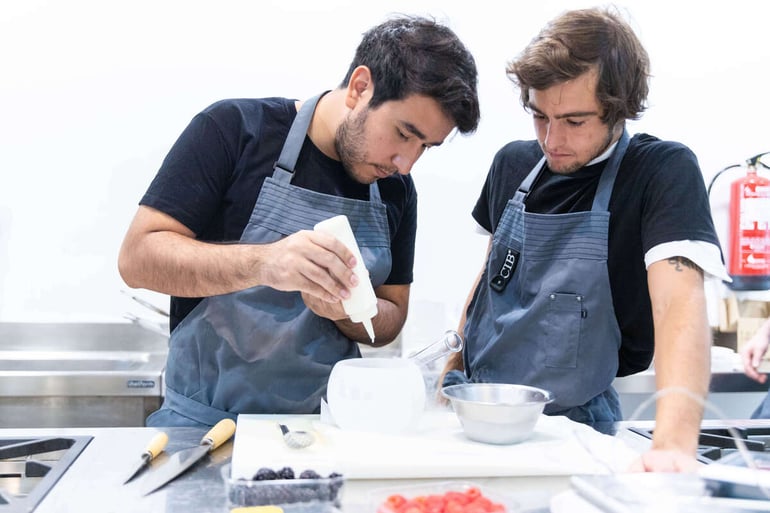
Deconstruction in molecular gastronomy
The term “deconstruction” was first introduced by Ferrán Adrià in 1993. Deconstruction in molecular gastronomy consists of using and respecting already known harmonies, transforming the textures, shapes and temperatures of the ingredients. A deconstructed dish preserves the “gene” of each of its products and the result is that when a diner tastes the dish, they relate the flavor to the classic recipe, even though they may not have recognized it at first.
When studying deconstruction, Adrià worked on one of the most recognized and representative dishes of Spanish gastronomy: the Spanish potato omelette. He started by putting onion jam, egg cream and potato foam in a cocktail glass. With this, Adriá managed to present a novel and unrecognizable dish in its presentation, but that, in essence, tasted exactly like Spanish potato omelette.
This technique was a culinary revolution both in Spain and abroad. Today, chefs from all over the world apply deconstruction in their dishes, along with other techniques, to offer diners a unique experience.
Distillation in gastronomy
Distillation involves separating soluble components by heating the mixture and evaporating the product with the lowest boiling point which, thanks to the presence of a refrigerant, gradually condenses.
In 2004, the Alícia Foundation and the Celler de Can Roca began a joint research project to incorporate what is called a rotavapor, a rotating distiller with a continuous vacuum that boils liquids at temperatures below 100ºC, therefore maintaining the aromas of the distilled food much better than if it were done using traditional distillation.
Later it was observed the potential that a rotary evaporator could have when creating new essences or new reductions in the kitchen, since this type of distillation achieves two types of by-products: the distillate of the food and the food reduced by cooking at low temperature, both very interesting materials.
The most volatile aromas end up in the distillate; they remain in the water. In the reduction, the components with a higher boiling point are obtained, the solution thickens because water is removed and the food is concentrated. In both cases, the products obtained have been “cooked” at temperatures below 100ºC, for example, liquids such as fruit juice can be distilled at 25-40ºC. One legendary creation in the world of rotary evaporation distillation was made in 2005 by the Celler de Can Roca, distilled earth.
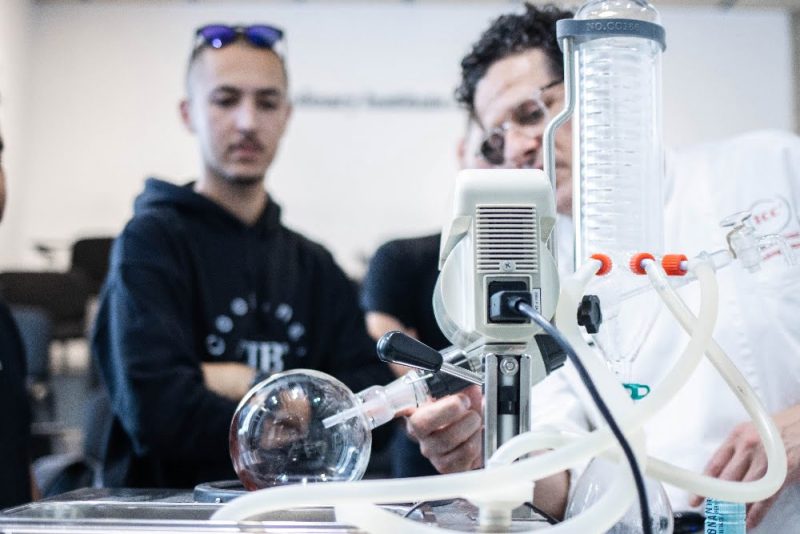
Foams and airs in the kitchen
Foams, seen from a scientific point of view, are a colloidal dispersion in which the dispersion medium is a liquid and the dispersed phase is a gas. In cooking, they take on different names depending on whether the foams have been made with one type of utensil or another, for example if an electric whisk is used to obtain a foam, the final result is an airy texture and it is called air, but if the chef whips using a siphon, it is called foam. They are totally different textures, but they are still a colloidal dispersion that stays more or less stable over time.
Currently, it is one of the most interesting forms of presentation, since foams improve the texture and experience of dense masses and also enhance their olfactory perception. This technique of creating foams and airs was also introduced by Ferrán Adriá. Both cold and hot foams can be created, the difference between the two lies in the stabilizing component and the way they are prepared.
